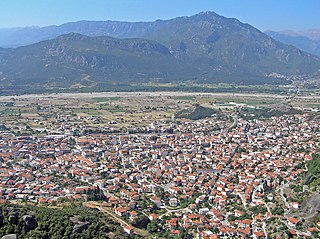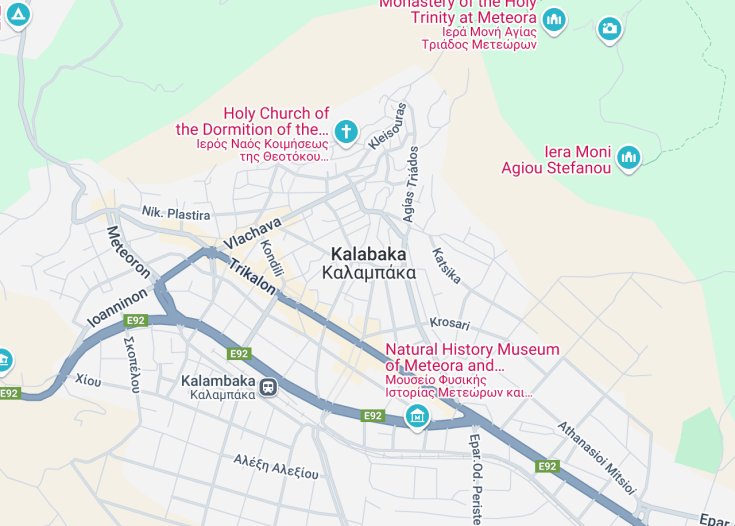Nestled at the base of the majestic Meteora rock formations, Kalabaka, a small town in Greece, enchants visitors with its unique blend of natural beauty and historical richness. The town serves as the gateway to the Meteora monasteries, which are perched atop towering cliffs, offering breathtaking views and a serene atmosphere.
Kalabaka itself is steeped in history, featuring charming streets lined with traditional architecture, local artisan shops, and quaint cafes. A visit here offers a perfect combination of spiritual reflection, cultural exploration, and scenic adventures.
Before visiting, check the schedule for monastery openings, as they vary throughout the year. Early morning visits are recommended to avoid crowds and experience serene views.
Make sure to wear comfortable footwear and bring water when exploring Kalabaka and the Meteora rocks, as the terrain can be challenging but is undeniably rewarding.
Top things to do & see in Kalabaka
Select the following sights and activities to discover best tickets and tours available in Kalabaka.
Kalabaka: Gateway to the Meteora Monasteries
| Country | Greece |
| Time in Kalabaka | GMT+2 |
| Language spoken | Greek |
| Population | 7,056 (source: Latest Census) |
| Currency | Euro (€, EUR) |
| Airports |
|
Kalabaka, a small town nestled at the base of the majestic Meteora rock formations in Greece, pulls visitors into a world where nature and human craftsmanship blend seamlessly. Known for its proximity to the Meteora monasteries, Kalabaka is more than just a starting point for spiritual exploration. Its streets, lined with sandstone buildings, echo the tales of countless pilgrims and travelers that have passed through this historical hub. Beyond its role as a gateway to the monasteries, this town boasts a rich history dating back to ancient times when it was known as Aeginium and later Christopolis.
The presence of Meteora’s monasteries, which appear to be precariously perched on massive sandstone pillars, defines the identity of Kalabaka. These structures blend Byzantine and post-Byzantine architectural elements, standing as a testament to monastic life dating back to the 14th century. Today, besides serving religious purposes, they attract rock climbers, photographers, and culture enthusiasts from around the globe, turning Kalabaka into a cultural melting pot.
Local festivals and culinary offerings provide further immersion into the Greek lifestyle. Events such as the Meteora Festival bring music and dance, while traditional tavernas offer local delicacies like pie with wild greens and tsipouro — a distilled spirit. In essence, Kalabaka is not just a place; it’s an experience—a convergence of spiritual solitude and vibrant social culture.
Where is Kalabaka?
Kalabaka is situated in northern Greece, near the Pindus Mountains, known for dramatic landscapes and monastic histories.
Distances:
| Route | Distance by car | Time by car |
| Athens to Kalabaka | 354 km | 4h 30m |
| Thessaloniki to Kalabaka | 230 km | 2h 40m |
What is Kalabakafamous for?
Kalabaka is renowned globally as the access point to the Meteora Monasteries, historic Byzantine monasteries built upon immense natural rock pillars, offering a unique blend of natural beauty and architectural marvel.
History
The history of Kalabaka, situated at the northwestern edge of the Plain of Thessaly in central Greece, unveils a tale of both human and natural grandeur, framed by the majestic rock pillars of Meteora that dominate the region’s skyline.
Prehistoric Times to Roman Era (Before 1st Century AD)
The area around Kalabaka has been inhabited since prehistoric times. Archaeological evidence suggests that early settlements were established here due to its strategic location and fertile lands. By the Roman era, Kalabaka was known as “Aeginium,” noted for being near the battle site where the Roman general Flamininus declared the freedom of Greece after the victory at the Battle of Cynoscephalae in 197 BC.
Byzantine Period (4th Century to 15th Century)
During the Byzantine period, the region gained religious significance with the establishment of the first monasteries on the Meteora rocks. Hermits seeking solitude and safety from the invasions and turmoil that characterized the era initially inhabited these natural skyscrapers. Over centuries, these ascetic settlements grew into larger monasteries, notably during the 14th century under the auspices of St. Athanasios Meteorites, who founded the Great Meteoron Monastery, the largest of the Meteora complexes.
Ottoman Occupation (15th Century to 19th Century)
Ottoman rule in Greece brought a different dynamic to Kalabaka. The town itself faced numerous challenges but the Meteora monasteries flourished in many ways as they received certain privileges from the Ottomans, which helped them to become centers of art and learning.
Modern Era (20th Century to Present)
In the 20th century, Kalabaka’s importance as a religious and tourist center grew significantly, particularly after World War II and the subsequent increase in global travel. The town has modernized while preserving its rich historical tapestry, characterized by its Byzantine churches, Ottoman architecture, and, most famously, the Meteora monasteries, which were recognized as a UNESCO World Heritage site in 1988. Today, Kalabaka is a vibrant blend of historical wealth and contemporary life, attracting visitors from all around the world.
Visit Kalabaka
What to see and do in Kalabaka, Greece.
Kalabaka serves as the gateway to the awe-inspiring Meteora monasteries, perched atop dramatic rock formations. Visitors should not miss exploring these historic monasteries, each offering a unique glimpse into monastic life and Orthodoxy.
Guided tours are available, providing insightful narratives of the monasteries’ histories and the area’s geology.
- Visit the Great Meteoron Monastery, the largest and oldest of the Meteora monasteries.
- Hike the numerous trails connecting the monasteries and enjoy stunning views of the valley.
- Explore the Natural History Museum, featuring exhibits on the region’s flora and fauna.
- Stroll through the old town of Kalabaka, enjoying the local cuisine and shops.
Festivals and Events
Kalabaka hosts several cultural and religious events throughout the year that reflect its rich heritage and religious significance. The Holy Spirit Monday, occurring 50 days after Easter, sees locals and visitors celebrating with festivals and fairs.
Additionally, the Meteora Music Festival in summer offers a blend of traditional and contemporary music performances, set against the backdrop of Meteora’s dramatic cliffs.
Best time to visit Kalabaka
The best times to visit Kalabaka are spring (April to early June) and autumn (September to October). These seasons boast pleasant weather, making it ideal for hiking and exploring the outdoor attractions without the extreme heat of the summer or the chill of winter.
Is Kalabaka worth visiting?
Kalabaka is undoubtedly worth visiting, not only for its historical and spiritual significance but also for its natural beauty. The Meteora monasteries offer a unique cultural experience, seeming to suspend between heaven and earth.
Alongside the rich history, the town offers modern amenities, making a trip here not just a step back in time but also a comfortable and enriching contemporary travel experience.









